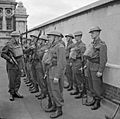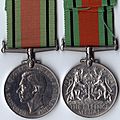British Home Guard facts for kids
The British Home Guard was a defence organisation of the British Army during World War II. It was a secondary defence line. It was meant to stop invasion by Nazi forces.
The Home Guard existed from 1940 to 1944. It was composed of one and a half million volunteers who were otherwise not allowed to go into military service. The main reason for this was old age. This led to the nickname "Dad's Army". The Home Guard guarded the coastal areas of Britain from enemy threats, like paratroopers. They also helped guard some industrial areas, such as factories and airfields. It was widely popularised after the war by the comedy show Dad's Army.
History
The beginning of the Home Guard are usually traced back to Captain Tom Wintringham. When returning from the Spanish Civil War, Wintringham wrote a book called How To Reform The Army. In it, he writes about how Britain could make something similar to the Spanish International Brigades in the Civil War. Although the book was well received, many of its suggestions were ignored at the time. This was because the tensions in Europe did not seem likely to escalate into war.
Following a series of events, Anthony Eden, the Secretary of State for War at the time, gave a radio broadcast on 19 May 1940. He asked for volunteers to join the Local Defence Volunteers, as it was known in the start. It originally was given jobs that were not related to combat. It worked as a sort of 'armed police force'. However, after complaints from members, the government allowed it to "delay and obstruct" the enemy advance. This was putting mostly untrained and unwell people armed with aging weapons against trained troops. Later on in the war, it was renamed the Home Guard, following pressure by Prime Minister Winston Churchill. If the Natzis had crossed the channel the Home Guard wouldn't have stopped the Germans for very long.
Images for kids
-
Lieutenant Percy Reginald Tucker Bermuda Home Guard (with the cap badge of the Bermuda Volunteer Rifle Corps)
-
A Home Guard platoon in 1941. All are equipped with US supplied weapons. The volunteer at the end of the front rank with a Browning Automatic Rifle; the volunteer at the end of the rear rank with a Mark III* Lewis machine gun; accompanied by one volunteer carrying a 47-round ammunition magazine. Other volunteers visible have M1917 Enfield rifles, and the sergeant has a Thompson sub-machine gun
-
Standard Mk II Beaverette II light reconnaissance cars manned by members of the Home Guard in the Scottish Highlands, 14 February 1941.
-
Two Local Defence Volunteers receiving instruction on either a Pattern 1914 or M1917 Enfield rifle. The two Volunteers are wearing the denim overalls over their ordinary clothes, one of them is wearing a collar and tie underneath. Note also the field service caps, the LDV armlets and civilian shoes worn without gaiters. The sergeant instructor is wearing standard battle dress.
-
Home Guard soldiers training with a Blacker Bombard anti-tank mortar in May 1943. The mortar is mounted on a concrete pillar in a pre-prepared pit; of which around 18,000 were dug
-
Lt Gen Lashmer Whistler (General Officer Commanding-in-Chief of the Western Command) with local Home Guard commanders at Oswestry, 1954
-
Zulfiqar Ali Bukhari training with the BBC Home Guard at Bedford College in 1941.
See also
 In Spanish: Home Guard para niños
In Spanish: Home Guard para niños












